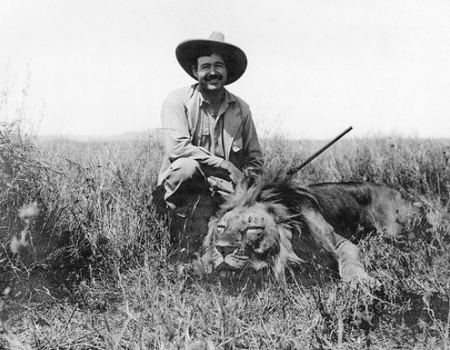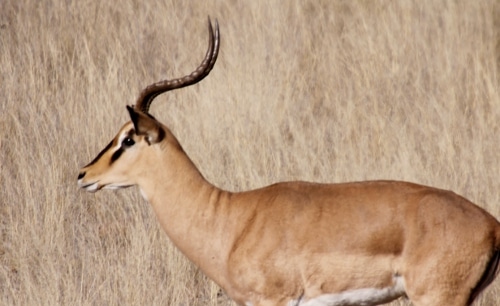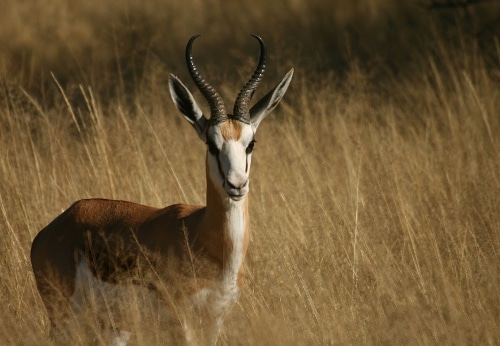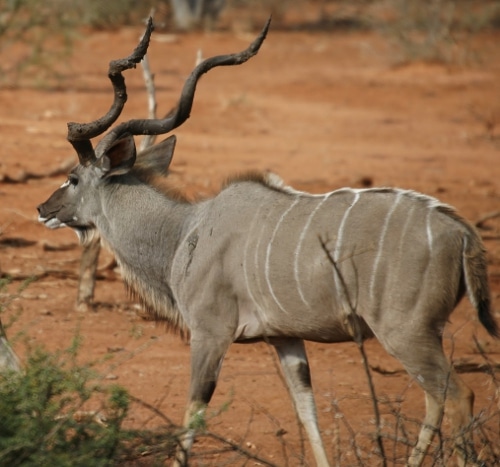
Editor’s note: This is a guest post from Steve Scott.
Man is a hunter.
No matter your take on where we as a species came from, both the pre and post historic man hunted as if his life depended on it…because it did. Life required hunter-gatherer to survive. Learn the art of hunting, and a man could feed himself. Become a skilled hunter, and a man would elevate in status and wealth, could take a mate, raise a family, and propagate the species. Failure as a hunter meant certain death…or vegetarianism.
And many men failed as hunters because it was really hard. Though Man is an apex predator, it took cunning, skill, and a lot of courage to pursue wooly mammoths, saber-tooth tigers, and giant sloths with stone axes, flint-tipped spears, and the occasional atlatl. Thankfully today, hunting is less of a life-or-death ordeal as Man’s oversized brain and advanced tools have more than made up for his limited physical abilities.
Modern weapons are infinitely more sophisticated and effective, and today, game is much more abundant. Because of far-sighted men like Theodore Roosevelt and Aldo Leopold and billions of dollars of support from hunters, the conservation movement was born. As a result, wildlife is thriving throughout North America. Yet while there are more hunting opportunities today in the United States than ever before, some intrepid hunters look beyond our shores to a continent where the flora is little wilder, and much of the fauna has a nasty propensity to turn the hunter into the hunted. I am referring, of course, to Africa.
Penetrating the Dark Continent
Though native Africans rightfully take issue, European explorers of the colonial age “opened” the continent from the 17th century on. Africa and its wealth of wildlife was a magnet for many a gentleman sportsman, soldier of fortune, and anyone who enjoyed wearing khaki. Fortunes could be made in a season with the “white gold” of the elephant tusk, and rhino horn was then, as today, in high demand in Asian and Middle Eastern marketplaces. Without regulation, much less enforcement of conservation imperatives, Africa’s great herds of pachyderms were pushed to the abyss of extinction. And though European colonial governments had a mixed record “managing” the lands they ruled, eventual development and enforcement of game laws eased pressure on African wildlife and paved the way for the golden era of African safari.
T.R., Hemingway, The Duke, et al.

On right, TR & son Kermit with a cape buffalo taken on the 1909 safari, which TR turned into a series of articles for Scribner’s Magazine.
Though commercial hunting ventures were already coming to the fore, Theodore Roosevelt’s grand safari of 1909 brought African safari and things like the pith helmet to the public eye. Financed by Andrew Carnegie and his own writing contracts, T.R., the stout, myopic ex-president and his son Kermit braved thirteen months traveling and hunting the Dark Continent, to ultimately gather the largest collection of natural history specimens ever donated to the Smithsonian Institute. The collection, which totaled 23,151 specimens, included insects, birds, and non-game mammals. It also included a number of lions, elephants and rhinoceros, along with a plethora of other big game species. Through his series of articles in Scribner’s Magazine and the eventual compilation that became the book African Game Trails, Roosevelt introduced the world to safari, and the rich and famous came in droves.

More than hunting can take place on safari. Here, two prolific writers, Roosevelt and Hemingway, ply their craft in the comfort of the open air office.
Inspired by Roosevelt’s adventures, Ernest Hemingway’s African safaris were both productive and nearly fatal. His hunting exploits were the basis for the classic novel The Green Hills of Africa, as well as the short stories “The Snows of Kilimanjaro” and “The Short Happy Life of Francis Macomber.” Hemingway took dangerous game on both expeditions, but it was not the game that nearly got him killed. On his second safari, Hemingway survived not one, but two plane crashes, adding to his legendary persona as a fearless adventurer and the manliest of authors.
Later in the 20th century, actor William Holden perpetuated the safari mystic with the Hollywood crowd and other notables of the day when he established the Mt. Kenya Safari Club in 1959. Through the decade of the 60’s and beyond, “The Club” became the retreat of choice for the glitterati, including crowned heads, luminaries of the day, and A-list actresses in fitted bush jackets. It also became a bastion of adventure for some of the most notable alpha males of the period, including Sir Winston Churchill, Clark Gable, Bing Crosby, Dwight D. Eisenhower, Sean Connery, and John Wayne.

Actors Gary Cooper & Clark Gable were members of the Mt. Kenya Safari Club.
With generals, knights, and the Duke shining a spotlight on the safari lifestyle, it was little wonder the not-so-rich and famous soon began to hunt Africa as well.
Safari for the Rest of Us
Today, Africa remains the Mecca of big game hunting, as more species of plains and dangerous game inhabit sub-Saharan Africa than anyplace else on earth. And while a full-bag Big Five (the five dangerous game species of Africa — elephant, rhinoceros, lion, leopard, and cape buffalo) safari in Tanzania can run north of $200,000, there are plenty of affordable big game safaris that can be had on a more modest budget…say mid-$5000 range, including airfare. Or put another way, a seven-day African safari with several species for the equivalent of a moderately-priced elk hunt in the Rocky Mountains. Think about that! Bottom line: an African safari is a doable proposition for most any man who is: 1) employed; and 2) has the desire to go.
A Bad Example: Me
When I booked my first African safari nearly 20 years ago, I was an idiot. Well, perhaps not an idiot, but my lack of knowledge of what I was getting into was laughable. For a seven-day plains game hunt in South Africa, I was working out hard every day to build my strength and endurance in the event I encountered a rampaging lion in the bush. Problem with my logic was, there are precious few free-ranging lions in South Africa, and if I did happen to encounter one, no amount of speed or strength would have saved my tender hide.
Operating on the premise that you are more likely to undertake something outside your comfort zone (like go on an African safari) if you have a general knowledge of the process, and can be reasonably certain you will not be mauled by a lion, here are a few tips that can help make your first safari a resounding success.
The How-To of Safari
Like any worthwhile project, having a solid plan for a safari will go a long way to insure its success. The single biggest factor in determining the outcome of a safari adventure is which operation the safari is conducted with. In other words, choosing a professional hunter, or PH is the hunters first, and most important decision.
1. Choosing A Professional Hunter:
The professional hunter is the jack-of-all trades of the safari. He acts as host, guide, tracker, outfitter, bartender, and sometimes cook, mechanic, or counselor. In short, the PH is the man in charge of everything that has anything to do with the hunt.
But how does one choose the right professional hunter with the myriad of choices available? Simply by doing the research.
Choosing the right PH/operator is much like finding a doctor or dentist when someone moves to a new area: ask others for recommendations; call references and see what kind of experience others have had, and make the decision based on the response.
Attending local or national hunting and safari shows provide a great opportunity to interact directly with professional hunters. Often, a firm handshake and face-to-face conversation can tell much about a man, even enough to know whether or not this PH is the right match for the hunter. Some of the bigger hunting conventions that provide an opportunity to meet a good number of African operators are held in January and February each year, including those of the Dallas Safari Club, Houston Safari Club, and Safari Club International (usually in Reno, NV).
Other good sources of information about African hunting opportunities include outdoor magazines and safari-oriented outdoor television programs. Safari DVD’s are also a good way to learn about various African operators, and the day-to-day routine of the African hunt.
2. What Do You Want to Hunt?
For the first-time African safari hunter, beginning with plains game is usually a good idea. Plains game are, for the most part, species that are NOT part of the Big 5 or Dangerous 7 (includes the Big 5, plus crocodile and hippopotamus). Plains game is a broad category that includes antelope and other species, and run the gamut of size and cost: from a pygmy antelope like the dik-dik (really) that weighs about 6 lbs, to the 2200 lb Lord Derby Eland. For a cost comparison, consider warthogs and impala that have trophy fees averaging around $350, while the bongo of central Africa regularly sell for $30,000 and more.

The “whitetail deer” of Africa, the impala is an abundant prey species that is found in most southern and east African countries.
So for most hunters, starting with the more common (and less expensive) species is the preferred choice.
3. Safari Costs
Though hunting in Africa is a financially-manageable endeavor, the client has to be able to budget the costs. The price structure of hunting in Africa consists of two main components: daily rates and trophy fees.
Daily rates are the per day cost of being in camp. Daily rates cover your food and lodging, daily laundry service, services of the PH, tracker(s) and skinner, transportation (in country) adult beverages (usually). In short: all of the things that make your hunting experience possible.

Common in arid regions of southwestern Africa, the springbok is a beautiful and abundant plains game species. It is also the mascot of the South African national rugby team.
Trophy fees are the charges for each animal harvested. Trophy fees vary based on supply and demand. Common springbok are well, common, in the arid regions of Namibia and South Africa and the trophy fees are relatively low. Conversely, though there are good numbers of kuduthroughout southern Africa, their elusive nature and striking and beautiful long spiral horns put this species on the top of most hunters’ safari wish list. Accordingly, trophy fees for kudu are higher than most other plains game species.

With its graceful movements and long, spiral horns, the kudu is always in high demand by safari hunters.
With dozens of species available through most hunting operators, it is literally possible to shoot one’s self into bankruptcy if the hunter does not maintain some semblance of fiscal control. It makes sense to decide before the hunt on a core list of species to pursue, with a couple of “maybes” in the event an outstanding specimen is encountered. It’s easy to be talked into taking a toad of a sable bull when he is standing broadside at 80 paces, but when it comes time for paying your safari bill at the end of the hunt, that extra $12,000 trophy fee might mean the kids miss out on their African souvenirs, or college tuition.
Sometimes, there are pricing alternatives.
Though most hunts are marketed on a daily rate/trophy fee basis, some operators are offering package hunts that are inclusive of all fees, sometimes even airfare. Providing economies of scale pricing will often lower the overall costs of the hunt to surprisingly affordable rates. The package I referred to earlier in the piece offered a seven-day hunt and four trophy fees, plus international airfare this past season for a remarkable $5650.
4. Deciding Where to Hunt
What country to hunt may be the first issue to decide, even before the determination of which PH to use. However, for the vast majority of first-time safari hunters, the countries of South Africa and Namibia are the destinations of choice. Why? They are safe, (THE issue for most first-timers in Africa) relatively inexpensive, and offer a great number of hunting options. In addition, most hunters feel they need to acquire African hunting experience before going in pursuit of dangerous game, which makes a lot of sense. Plains game hunting, be it in South Africa, Namibia, or one of the northern countries, is great preparation for the inevitable desire to eventually chase creatures that can and will bite back.
African Safari Within Your Grasp
An African hunting safari is not for everyone, but the cool factor alone is enough to send many a first-time hunter across the pond. Exotic lands, pristine nature, and abundant wildlife straight out of Nat Geo Wild is the appeal for others. But whatever the motivation, an African safari is an obtainable goal for almost everyone. Forgo that daily stop at Starbucks and eat out one less time per week and in a couple of years, your safari account will be fully funded. It is strictly a matter of setting priorities, saving, and planning, and with a little time and fiscal discipline, you will soon be pursuing some of the great game animals of the world. But be warned: Africa is an addictive itch that is not easily scratched. For most safari hunters, the first trip to the Dark Continent will seldom be their last.
_____________________________
Steve Scott, a reformed attorney, former college professor, and full time outdoor television producer can be found at stevescott.tv and followed at @stevescotttv.


